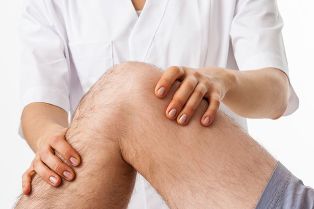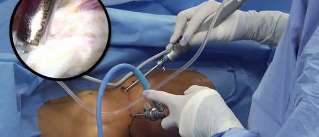What does the diagnosis of "osteoarthritis of knee"
We are talking about the disease in which the cartilage is deformed and destroyed. Cartilage, being a dense fabric that acts as a buffer to any union, it is necessary to your movement. When breakdown of cartilage in the joint gradually loses mobility, but if the disease is not treated, then completely ceases to work. However, in the early stages of osteoarthritis can be treated with medication and physiotherapy.

By the way, Around 12% of young people who suffer from arthritis, and retirement, this figure is above the half — a quarter of all of the major complain of the symptoms of this disease.
Women suffer from osteoarthritis more often than men.
The risk group also includes athletes in active training, and microtrauma of the cartilage often lead to the restriction of mobility of joints at an early age.
There is evidence that in osteoarthritis there is a certain genetic predisposition. If you have a family there were cases of this disease, you should carefully monitor the state of the joints.
The causes of the disease
The reasons for the development of osteoarthritis of the knee a lot. These include:
- the trauma and microtrauma of the joints;
- excess weight is an extra load of the knee joint;
- metabolic disorders in which cartilage in a lack of essential nutrients;
- load level during the physical work or excessive intensive training;
- dysfunctions of the circulatory system, in which impairment of the nutrition of the cartilage tissue;
- prolonged spasms of blood vessels of the legs. Extent of knee OA and symptoms
Osteoarthritis of the knee develops gradually.So there are different degrees of this disease.
1 degree. In this stage, the changes are still minor and may even try to determine the instrumental surveys. For the development of osteoarthritis of the indicative symptoms, such as slight stiffness of the joint after a long immobility (often in the morning) and crunching in the joint when sudden movements. Intense pain is, usually, so that often people ignore these signs and go to the doctor only when knee reaches the 2nd phase.
2 the degree of deformation of the Joint, x-ray notable widening of the joint space and deformity of the cartilage. Symptoms become pronounced patients complain of constant pain, which increases with the start of movement, restriction of mobility, a noticeable stiffness in the morning. A small effort (for example, elevation) also causes pain. Sometimes the skin over the joint turns red, swells a bit and becomes warm to the touch — this indicates that the development of the inflammation. With osteoarthritis of the knee grade 2 patients report increased pain when the weather changes or after the exposure.
3 degree. Severe osteoarthritis of the knee is characterized by severe pain on all movements, lameness, and sometimes a marked shortening of the limb. The joint area is very swollen, and in the morning, people can not get out of bed — sometimes you have to wait half an hour before the motility is partially restored. When 3rd degree osteoarthritis of the knee joint cartilage significantly thinner, and in some places completely destroyed, so that the bones touch each other.
4 the degree. The complete destruction of the cartilage, excruciating pain and immobility — that is what you get, if you ignore the signs of osteoarthritis at the latest. The articulation of the space is lost and it starts the deformation of the bones. Of diagnosis as the first stage of treatment
If you suspect the disease you should immediately make an appointment to see a doctor of podiatrist, who diagnosed it.
Diagnosis of osteoarthritis involves laboratory and instrumental methods.
The first is General and biochemical blood and urine analysis. These tests help to exclude autoimmune diseases, that leads to the defeat of the joints, to determine the presence of inflammation.
Of instrumental methods of diagnosis of osteoarthritis most often used simple radiography in two projections, ultrasound, computed tomography, magnetic resonance imaging.
Methods of treatment of osteoarthritis of the knee
Osteoarthritis of the knee is treated, but the prognosis is more favourable if you start the treatment as soon as possible in the 1-2 stages of the disease. Many methods of treatment, but only a comprehensive treatment gives the desired result.
Among the most effective methods of shock wave, drug therapy, traction of joints, intra-joint administration of drugs, muscle toning and physiotherapy (physical therapy).
Drug therapy
Helps you to deal only with the symptoms.
Nonsteroidal anti-inflammatory drugs
reduce the inflammation and pain.
chondroprotectors
stimulate the nutrition of the articular cartilage. As a Complement to widely used ointments and gels, with the analgesic effect, as well as with external funds to relieve the inflammation and improve microcirculation.
UHT
Shock wave therapy — the method by which the therapeutic effect is achieved by the effect of sound waves on tissue in the joint. This is a relatively painless procedure, which, however, allows to obtain impressive results in relieving pain, to destroy and to soften calcium deposits (osteophytes), improve the metabolic processes in tissues, normalize the blood flow and relieve the swelling, the language of ordinary people — "clean up" the joint. The effectiveness of treatment reaches 90%.
Physical therapy
Therapeutic exercise — it is almost a necessary part of the therapy of osteoarthritis of the knee. kinesitherapy is a specific exercises with a carefully calculated load and the hydrotherapy — exercises that are performed with specialized medical devices. Physical therapy allows you to restore the joint mobility, improve blood flow, develop and strengthen ligaments.
The tensile strength of joints
Traction, or traction of joints is carried out on a special brace. This method extends the joint and extends to the whole of the space, which is equivalent to reduce the friction of the joint surfaces and the patient's joint is unloaded. The positive effect observed in 80% of cases.
Intra-articulate injections
Is how to drain excess synovial fluid, and the injection of drugs — anti-inflammatory, analgesic and improves blood flow to the articular cartilage of drugs, etc.
It is necessary to explain how a method of injection the patient plasma in the whole of the capsule of the growth factors contained in plasma. They accelerate the recovery and regeneration of damaged articular cartilage. The advantage of PRP is that on its own the plasma is not allergies, this is a safe biological stimulator of regeneration. 2-3 months after a course of PRP, patients note that the pain and stiffness has decreased to half, and the mobility of the joint improves.
Muscle tone
Method of treatment based on stimulation of the musculature microcurrents. In the case of osteoarthritis of the knee joint is atrophy of the thigh muscles, compromised blood supply. This dramatically increases the load on the joints.
Stimulation helps to strengthen these muscles, something to relieve the load on the joints, improves the circulation of the blood, to form a solid framework for the joint.
Surgery

arthroscopic debridment. Method used for the elimination of the articulation of the elements of the destroyed cartilage, meniscus part. The operation is performed under video control. The endoprosthesis. If the joint is completely destroyed, it can only be replaced by an artificial. The endoprosthesis used only in the most severe cases, the third or the fourth stage of the disease.
Your new knee will have a duration of 12-15 years. For the timeliness in the diagnosis of osteoarthritis of the knee is important not to throw and not to postpone the visit to the doctor and self-medicate with over-the-counter remedies.
Osteoarthritis develops gradually, but in some people, among the first symptoms of the disease and the time to save the whole can only operation, after only a few years, it all depends on the individual. In most cases, early diagnosis and comprehensive approach to treatment can help control symptoms of arthritis and restore joint.













































